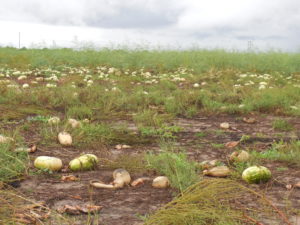By Shawn McCowan, Texas FSA Public Affairs Specialist

Doug Harper is a fifth-generation farmer who grows cotton and watermelons along the coast in Victoria County, Texas. (Courtesy Photo)
Doug Harper, a fifth-generation farmer, moved to the Texas Gulf Coast area in 2012, looking forward to the potential for increasing corn, cotton, milo, and watermelon production there.
Texas farmer Doug Harper comes from a long line of farmers. Growing up in the business, he knows there are always ups and downs, and the importance of insurance coverage to prevent against the “what ifs?”
When challenges arose this past year, a USDA program enabled Harper to recover.
First, an unexpected large surge in watermelon production last June caused truckloads of watermelon to backup, including a few trucks full of Harper’s freshly harvested watermelons. Because of the delay in getting these watermelons to market, they were all rejected.

Disaster assistance through FSA has helped Doug Harper rebound over the years. (Courtesy Photo)
“I lost all profits, and I wasn’t expecting to recover anything after that loss,” Harper said.
But his losses were covered through the Noninsured Crop Disaster Assistance Program (NAP), which provides financial assistance to producers of noninsurable crops when low yields, loss of inventory, or prevented planting occur due to natural disasters. Beginning, limited resource and targeted underserved farmers or ranchers are eligible for a waiver of the service fee and a 50 percent premium reduction when they file form CCC-860, “Socially Disadvantaged, Limited Resource and Beginning Farmer or Rancher Certification.”
“(The program) saved me about $100 per acre,” he said.
Harper thought he had weathered the season’s crisis, but something much worse was close behind.
When Hurricane Harvey began its approach two months later toward the Gulf Coast, Harper quickly organized six trucks to begin moving as much of his cotton to higher ground that was possible. The day before the hurricane made landfall, he evacuated and hoped for the best.
He returned to find the hurricane devastated his crops, destroying more than 800 modules of cotton. When cotton is harvested, it is compressed into large modules that can weigh up to 5,000 pounds. Very little of his crop was salvageable. Even his entire 80-acres of watermelon were completely lost, just two weeks from blooming.
As part of the program, Harper reported the losses to his local office of USDA’s Farm Service Agency, which administers the program.
“Knowing I was covered by NAP took some of the stress away at a very difficult time,” Harper said. “I couldn’t help but wonder where I would get money to pay our bills, let alone rebuilding after such a loss.”
Harper said he believes the program will always be worth it to him.
“I highly recommend taking advantage of NAP,” he said. “It’s low-cost, good coverage. I will definitely continue to use NAP, and encourage others to do the same.”
Deadlines to apply for NAP coverage vary by state and crop. Contact your local FSA office to schedule an appointment to enroll. To find your local USDA Service Center visit offices.usda.gov.

Just two weeks away from blooming, Harper’s 80-acre watermelon crop along the Texas coast was lost after salt water covered the field because of storm surges from Hurricane Harvey. (Courtesy Photo)





